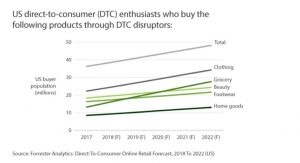What can today’s industry shifts tell us about the future of SEO and content marketing? Columnist Jim Yu discusses some current trends and their implications.

Google has thrown a lot at marketers in just the last five years. All of these big changes — from rolling out major algorithm updates to shifting to mobile-first — have essentially had the same goal: to provide the best possible search experience to users. Google wants to show users the best content at the right time on the right device as quickly as possible.
Some marketers have struggled to keep up with and adapt to these huge changes. Meanwhile, other brands are thriving. Why? Because they have learned to stay ahead of Google’s ever-evolving algorithms by focusing on content and quality.
Smart marketers know that they must have similar goals to Google. That means providing content that resonates, engages and converts — wherever, whenever and however consumers discover it.
It’s important to not just look at where Google is today, but where Google is heading over the next six months, next year and beyond. If you can stay ahead of these momentous shifts, you can stay ahead of Google and your competition to dominate online in your industry.
The future in search is now. It’s time to start thinking forward — and fast! Below are five SEO shifts that you need to master as we head into the latter part of this year.
1. From SEO to ‘SEO and content convergence’
Just as content alone isn’t enough to guarantee SEO success, SEO alone isn’t enough to guarantee that people will find and engage with your content. Data is helping marketers understand consumer intent to create intelligent content that aligns with the customer journey to deliver a successful and memorable experience.
How marketers can master this shift:
- Ensure your content creation is based on data. Content marketing without data lacks purpose. Define the audience, engagement and conversion metrics that matter to your brand. Track and measure these to gain the insights you need to create meaningful content that people want to consume and improve future content marketing efforts.
- Foster search, social and content synergy. In combination, organic search, social and content help brands achieve their goals and objectives. Creating high-quality content with SEO in mind from the beginning boosts search visibility. That great content can then be further amplified via social media, which creates demand you can later harvest via search.
- Maximize your search engine results page (SERP) footprint. Create and optimize high-ROI content like articles, videos and infographics to help people (by answering important or popular questions or providing practical information) or capitalize on trendy topics. Then help your brand further stand out in the SERPs by winning real estate with featured snippets, site links, related questions, images, videos and tweets.
2. From mobile to mobile-first
For years, Google told marketers about the coming shift to mobile first — and it finally arrived in 2015, when mobile searches surpassed desktop. Today, optimizing for mobile search, devices and usability is no longer optional. It’s mandatory. Your brand must be mobile-ready if you want to capitalize on mobile micro-moments.
How marketers can master this shift:
- Recognize that this is a mobile-first world. Brands that aren’t mobile-optimized see 68 percent less traffic, according to BrightEdge research (my company). This means that understanding mobile user behavior and intent is essential today. Make sure your mobile experience meets (but ideally exceeds) expectations, or you risk losing market share and revenue to the competition.
- Make your mobile SEO fast and furious. In addition to being attractive and easy to navigate, mobile websites must be fast. According to Google research, 53 percent of mobile users leave sites that take more than three seconds to load. Following technical mobile SEO best practices (e.g., image optimization, redirects, JavaScript and CSS) is a necessary barrier to entry in today’s digital world.
- Consider contextual mobile content. Focus on creating content that mobile users want and will find valuable. Typically, mobile users are in research mode — they are searching for information they need or they need some inspiration. Make sure your brand is there and influences that decision when they’re ready to convert, which is more likely to be on desktop or in store than on a smartphone.
3. From local to hyperlocal
The hyperlocal opportunity has never been greater for marketers. Hyperlocal targeting lets you reach people based on their location. This is an excellent way for brands to capitalize on “near me” searches and “I-want-to-go” micro-moments and become hyperrelevant and hypervaluable.
How marketers can master this shift:
- Own local search. Make sure critical contact information that people search for is prominent or easy to find. This includes name, address, phone, hours and directions.
- Hyperlocal optimization = hyperimportant. Google’s personalized hyperlocal results give more visibility to smaller geographic locations. Optimize your Google My Business page, create localized content and landing pages, use local business Schema markup and monitor the performance of your local keyword rankings.
- Understand the intersection of local and mobile. People who do local searches on smartphones have higher intent: 50 percent of smartphone users will visit a business or store within a day, according to Google. Optimizing for local also means optimizing for users who are on the go. These people have different needs and expectations than those doing local searches on other devices.
4. From text to voice
About 20 to 25 percent of mobile queries are voice searches, depending on who you believe at Google. Although it’s clearly far too soon to declare the death of text searches, voice search is an emerging area marketers need to pay attention to heading forward. Voice search will continue to rise as consumer adoption of virtual assistants (e.g., Siri, Alexa) increases.
How marketers can master this shift:
- More voice searches, more answers. Voice search will bring different types of search results because the majority of voice searches are questions (who, what, where, when, why, how). Fortunately for marketers, these questions also reveal user intent. Identify high-intent keywords, and optimize content that answers these questions to ensure your brand will be found in the changing SERPs.
- Urge to voice search rising. People are adopting voice search because it is now more accurate and useful than ever — it is faster and easier than typing on a smartphone keyboard. By 2020, 50 percent of all searches will be voice searches, according to a forecast from comScore. Identify and provide content in a format that meets the needs of these types of searchers.
- Get smart about intelligent agents. Many voice searches happen at home, in addition to in the car or on the go, resulting in a more connected world. These intelligent agents are using semantics, search history and user interests and behaviors to provide the best results. So, make sure content is aligned with the intent and interests of customers at the right moment of the decision journey. Be the best answer. Forrester analyst Collin Colburn shares some great insights on this topic in this Forrester blog.
5. From data to machine learning
Google relies in part on machine learning, in the form of RankBrain, to make sense of the massive amounts of data and deliver the best possible search results for users. As marketers, we, too, must turn to machine learning to understand the intent, interests and behavior of our audience so we can deliver and personalize content that they want.
How marketers can master this shift:
- View data as a source of truth. Martech stacks are being built around data integrations and performance because we simply have too much data and not enough analysts or hours in the day to make sense of it all. To capitalize on demand, spot patterns and stay ahead of the competition, marketers need to go beyond the “what” of data to understand the “when” and “why” of analytics.
- Utilize AI & machine learning. Machine learning helps marketers spend less time analyzing data and more time creating content that will engage and influence prospects and customers. Let AI and machine learning deliver actionable insights about your audience and content performance.
- Define metrics and measurement. Data allows marketers to make better and more accurate decisions more quickly. Define the metrics that matter to your brand, and monitor your search and content data. This will allow you to track your progress, iterate and improve your content production and organic search optimization for greater visibility and greater share of voice.
Conclusion
With $80 billion forecast to be spent annually on SEO — and content marketing set to be a $300+ billion industry by 2019 — it might be tempting for stakeholders to view SEO and content marketing as cost centers rather than revenue centers. This would be a mistake. SEO and data are essential for a successful integrated digital strategy with a tangible ROI. By understanding the five points above and always measuring your results, you will be able to demonstrate that creating effective, engaging, intelligent content is the path to revenue and truly worth the investment.
[Article on Search Engine Land.]
Some opinions expressed in this article may be those of a guest author and not necessarily Marketing Land. Staff authors are listed here.
Marketing Land – Internet Marketing News, Strategies & Tips
(39)
Report Post







